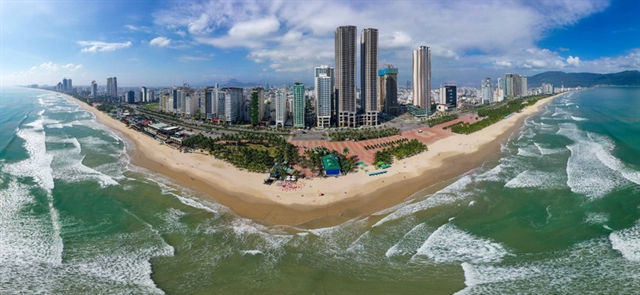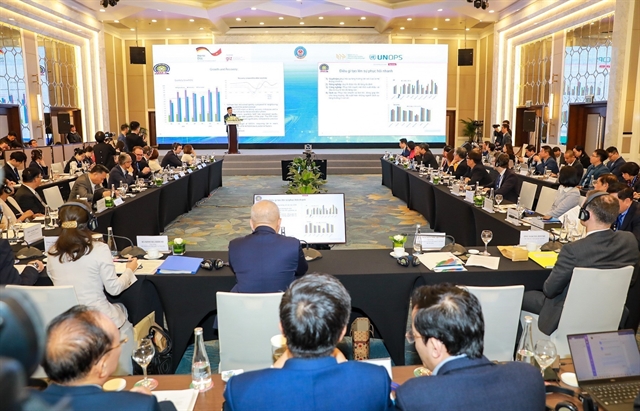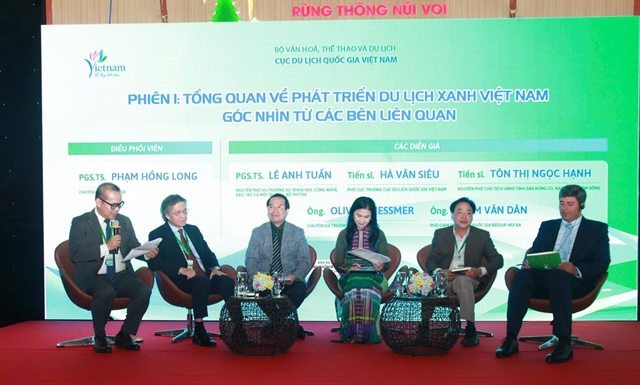 Economy
Economy

 |
| A view of the Vietnam Low-Altitude Economy Forum 2025 in Hà Nội on November 14. — VNA/VNS Photo |
HÀ NỘI — Việt Nam is now at the ‘golden time’ to develop a low-altitude economy, creating an entirely new economy based on aerospace and UAV technology, FPT Group’s Chief Technology Officer Vũ Anh Tú stated at the Vietnam Low-Altitude Economy Forum 2025 in Hà Nội on November 14.
The event was jointly held by the Vietnam Aerospace, Space, and Unmanned Aerial Vehicles (UAVS VN) in collaboration with FPT Group, the Vietnam Low-Altitude Economy Alliance, overseas Vietnamese innovation networks, and the Vietnam National Innovation Center (NIC). It gathered representatives from global companies, innovation networks, and international partners, highlighting the potential of UAVs and aerospace technology in developing the low-altitude economy, fostering a new and sustainable industry and serving as a pillar for the digital economy, smart cities, and modern agriculture.
In his opening remarks, Tú stressed that the global market of low-altitude economy has reached hundreds of billions of dollars, growing 30 per cent annually, and is recognised by major economies such as the US, China, and Europe as a strategic industry.
He noted that the ‘Vietnamese sky’ offers an unprecedented development space, especially as the Mekong Delta becomes the country’s largest UAV application area and a testing ground for many international corporations.
Analysing the growth potential of the low-altitude economy, Tú noted that it opens the door to an entirely new sector in Việt Nam. Beyond UAV manufacturing, it encompasses devices, chips, sensors, air traffic management platforms, 3D mapping, operational services, insurance, training, and applications in agriculture and other fields.
This sector stands at the intersection of the digital, green, and knowledge-based economies, he said, adding that investing in the low-altitude economy is an investment in Việt Nam’s three new pillars of scientific development.
Võ Xuân Hoài, Deputy Director of NIC, affirmed that aerospace and UAV are among the world’s strategic industries, with 70 per cent of the UAV market dominated by major companies. He emphasised that this presents an opportunity for Việt Nam to engage deeply in the value chain, from research and manufacturing to software development, AI and air traffic management.
He also praised the technological self-reliance of Vietnamese UAV companies and stressed the need for close coordination among the State, businesses, research institutes, and international partners.
A notable step is NIC’s recent proposal to establish Việt Nam’s first UAV testing airspace, laying the groundwork for domestic product commercialisation, Hoài said.
Analyses at the forum highlighted that the low-altitude economy not only creates new industries but also directly boosts economic productivity. In agriculture, which accounts for 12-14 per cent of the national GDP and employs up to 40 per cent of the workforce, UAVs are driving a leap in automation. Vietnam’s agricultural robotics market is projected to reach US$400 million by 2030.
In logistics, as e-commerce is forecast to reach $63 billion by 2030, UAVs are expected to cut delivery costs, especially in challenging terrains. Successful trials in Thái Nguyên, Tuyên Quang, and Lạng Son have shown positive results.
For smart cities, UAVs are expected to become vital tools for monitoring traffic and infrastructure safety, enhancing emergency response capabilities.
The low-altitude economy refers to economic activities conducted below 1,000 metres, extendable up to 5,000 metres depending on a country’s demands. This sector leverages manned and unmanned flight technology and low-altitude smart networks to develop infrastructure, manufacture aerial vehicles, provide related services, and ensure flight safety. Its applications span agriculture, logistics, environmental monitoring, transportation, media, and entertainment, tapping into the underutilised lower airspace. — VNS




